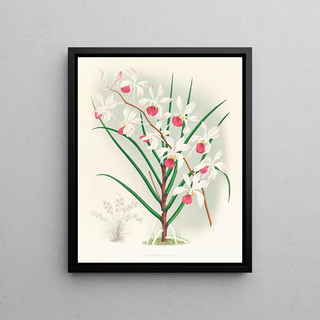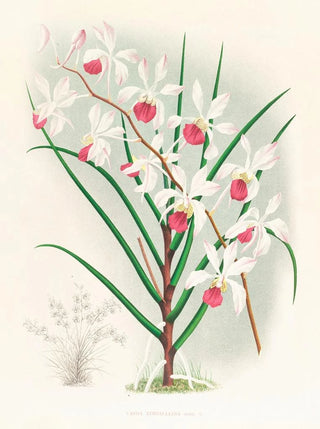Art print | Vanda kimballiana - Jean Jules Linden


View from behind

Frame (optional)
The Vanda kimballiana art print by Jean Jules Linden – Captivating introduction
Nature, in all its splendor, has always been an inexhaustible source of inspiration for artists. Among them, Jean Jules Linden stands out for his ability to capture the ephemeral beauty of flowers, transforming fleeting moments into timeless works of art. The Vanda kimballiana art print by Jean Jules Linden perfectly illustrates this quest for harmony between art and nature. This piece, highlighting the delicacy and richness of the Vanda orchid's colors, invites the viewer to silent contemplation, an escape to a world where beauty reigns supreme.
Style and uniqueness of the work
Jean Jules Linden's style is characterized by meticulous attention to detail and a vibrant color palette that breathes new life into his floral subjects. In "Vanda kimballiana," the artist manages to capture the velvety texture of the petals, their natural shine, and the complexity of their structure. Every shade of violet, pink, and white is rendered with such precision that it almost feels tangible. The composition of the artwork, both dynamic and balanced, draws the eye and guides it through the various elements of the plant, creating an immersive visual experience. Linden does not merely depict a flower; he evokes a feeling, an atmosphere, plunging us into a universe where nature reveals itself in all its magnificence.
The artist and his influence
Jean Jules Linden, born in 1817 in Brussels, is one of the pioneers of botanical painting in the 19th century. His passion for botany led him to travel around the world, collecting specimens and observing flora in its natural habitat. His work was heavily influenced by the Romantic movement, which valued emotion and the beauty of nature. As a member of the Society of Friends of the Arts, Linden contributed to the rise of floral painting in Europe, inspiring many contemporary artists. His ability to marry science and art made him an iconic figure in botanical painting, and his legacy endures through generations, testifying to the importance of nature in art.
Wall decoration

Matte finish

View from behind

Frame (optional)
The Vanda kimballiana art print by Jean Jules Linden – Captivating introduction
Nature, in all its splendor, has always been an inexhaustible source of inspiration for artists. Among them, Jean Jules Linden stands out for his ability to capture the ephemeral beauty of flowers, transforming fleeting moments into timeless works of art. The Vanda kimballiana art print by Jean Jules Linden perfectly illustrates this quest for harmony between art and nature. This piece, highlighting the delicacy and richness of the Vanda orchid's colors, invites the viewer to silent contemplation, an escape to a world where beauty reigns supreme.
Style and uniqueness of the work
Jean Jules Linden's style is characterized by meticulous attention to detail and a vibrant color palette that breathes new life into his floral subjects. In "Vanda kimballiana," the artist manages to capture the velvety texture of the petals, their natural shine, and the complexity of their structure. Every shade of violet, pink, and white is rendered with such precision that it almost feels tangible. The composition of the artwork, both dynamic and balanced, draws the eye and guides it through the various elements of the plant, creating an immersive visual experience. Linden does not merely depict a flower; he evokes a feeling, an atmosphere, plunging us into a universe where nature reveals itself in all its magnificence.
The artist and his influence
Jean Jules Linden, born in 1817 in Brussels, is one of the pioneers of botanical painting in the 19th century. His passion for botany led him to travel around the world, collecting specimens and observing flora in its natural habitat. His work was heavily influenced by the Romantic movement, which valued emotion and the beauty of nature. As a member of the Society of Friends of the Arts, Linden contributed to the rise of floral painting in Europe, inspiring many contemporary artists. His ability to marry science and art made him an iconic figure in botanical painting, and his legacy endures through generations, testifying to the importance of nature in art.
Wall decoration






